
Wondering about the best time to visit Xi’an? We have you sorted. In this detailed guide for international travelers, we’ve gathered all you need to know about this vibrant city. Where Beijing is serious, offering up its imperial pomp and contemporary politics, Xi’an offers visitors a lively and lighter experience.
Choosing the right time to explore Xi’an based on your preferences and interests will ensure you gather beautiful travel memories that last a lifetime. Whether strolling under cherry blossoms along ancient ramparts or cycling amid golden ginkgo-lined avenues, each season has its benefits. Against a backdrop of sensational weather, vibrant local festivals, and an evolving culture, Xi’an has all the hallmarks of a great holiday destination.
Our years of designing exceptional Xi’an journeys for travelers worldwide have been distilled right here. You’ll learn which months offer the ideal climate, how to sync your visit with unique cultural celebrations, and where to uncover seasonal treasures. Regardless of whether it’s Xian’s gorgeous spring blooms, stunning colours of autumn, or the delicious dishes served during these seasons, we share every detail so you experience Xi’an at its very best.
Spring and autumn: Xi’an at its best
Undoubtedly, experiencing Xi’an at its best means visiting during two magical windows: from March through May, when spring breathes new life into ancient courtyards, and in September to November, as autumn cloaks the city in a tapestry of gold and crimson. It’s these times of year when Xi’an comes alive.
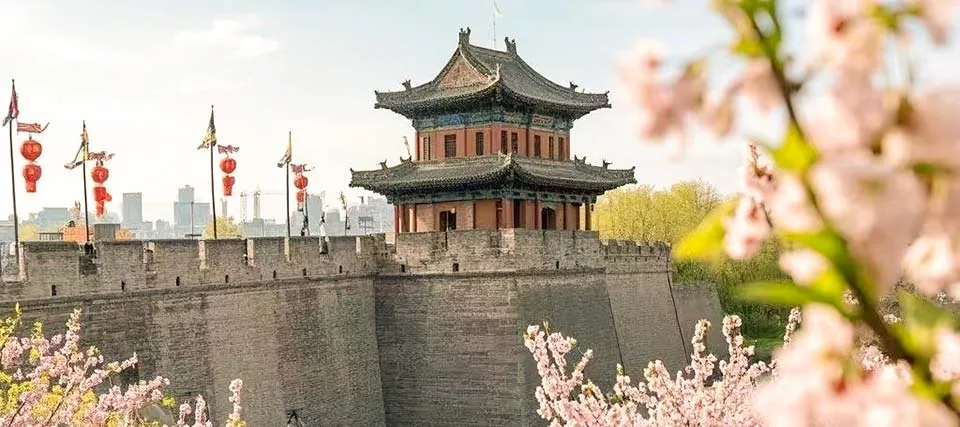
Xian in Spring: Blooming, beautiful, and ambient
From March to May, Xi’an enjoys warm and dry weather with daily temperatures ranging from 10°C to 25°C. With over 70 percent of spring days blessed with sunshine, spring offers perfect conditions for both outdoor adventures and cultural exploration. The city erupts into bloom – roses and cherry blossoms abound – and you cannot miss the fragrance that carries across the city centre. It certainly makes for ideal traveling temperatures.
Best sites for a spring Xi’an visit
Xi’an is synonymous with its ancient City Wall, which has been meticulously maintained in much of its original condition. Cycle around this former fortress and imagine the view that former city guardians took in. Adjacent to the Xi’an City Wall is Huancheng Park (also referred to as City Wall Park) which transforms into a floral sea of magnolia, apricot blossom, and Chinese flowering crabapple. The traditional architecture nestled within this colourful tapestry is at the very least photo worthy, but at best, perfectly captures the essence of Xi’an’s history.
If you love flowers, then Qinglong Temple is Xi’an’s top spot for cherry blossom viewing. Home to more than 600 cherry trees across eleven varieties, the temple grounds transform into a breathtaking sea of pink and white blossoms from mid-March to late April. These delicate flowers perfectly frame the ancient Tang Dynasty architecture and many stunning photographic memories have been caught on film here.
In keeping with the floral theme, Daming Palace National Heritage Park in Xi’an is perfect for a spring visit, with its expansive grounds, blooming flowers, and peaceful gardens. Magnolia, plum and apricot blossoms, Chinese crabapples, pear and peach blossoms, winter jasmine and other flowers bloom in artful sequence, attracting a large number of locals and tourists to enjoy flowers and take photos. Strolling beside Taiye Pond amid blossoming greenery, you can enjoy fresh air and scenic views while stepping back into the grandeur of the Tang Dynasty.
Tang Paradise awakens in spring with vivid bursts of color in its gardens. The exquisite Tang Dynasty architecture, distinctive through its intricate construction, blends beautifully with garden surrounds, offering more perfect photo opportunities. Each pavilion, bridge, and sculpture is revitalized, set against the lush, colorful backdrop of spring’s arrival. It is an ideal place for a Hanfu photoshoot experience.
Located next to the Big Wild Goose Pagoda, the Tang Dynasty style Da Ci’en Temple Ruins Park offers a great view of the Big Wild Goose Pagoda. Not only does a visit here offer the perfect opportunity to capture both the Buddha statue and the Pagoda, it is also a unique place to experience the changing scenery of Chang’an – blossoms in spring, the fallen leaves in autumn, and the snow in winter.
For yet more flowers, Xingqing Palace Park is another popular spot. From March to May, the park’s tulips, peonies, and Chinese peonies flourish in vibrant colors, attracting numerous visitors. Planning your Xi’an tour to kick off in early April? Make a beeline here to lay your eyes on over 200,000 tulips clashing in vibrant colors from red through to yellow, white, and purple. Alongside tulips, you’ll also find cherry blossoms, lilacs, bauhinia, yellow roses, osmanthus and wisteria, creating a breathtaking floral spectacle.
Xi’an’s spring food favorites
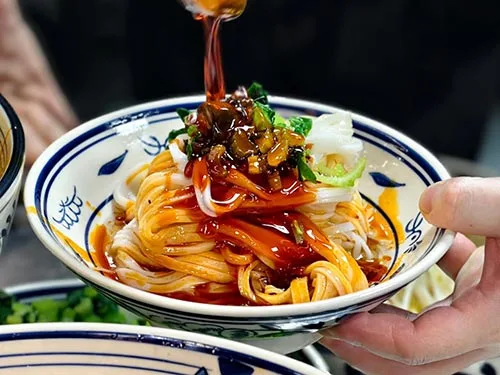
Xi’an Liangpi: Spring’s Cooling Comfort
While Cold Noodles (Liangpi) are beloved year round, spring marks the beginning of the season for this refreshing cold noodle dish. Made from wheat or rice flour and served with a tangy blend of sesame paste, chili oil, cucumber, and bean sprouts, Liangpi offers the perfect balance of spicy, sour, and savory flavors. Liangpi is light yet satisfying and provides the perfect spring day sustenance.
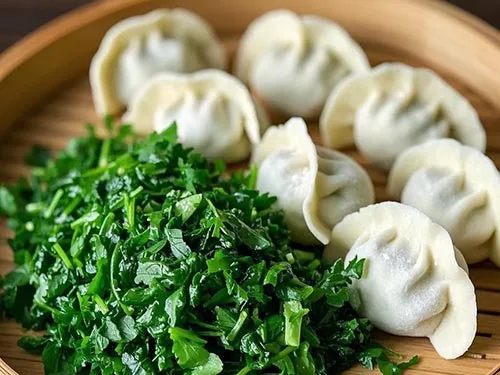
Local Xi’an cuisine coloured by fresh wild vegetables
Spring in Xi’an brings a fresh variety of seasonal vegetables that local chefs use in both traditional dishes and seasonal specialties. These wild vegetables, such as Chinese toon leaves (xiangchun), Shepherd’s Purse (jicai) and alfalfa sprouts (musu), elm seeds (yuqian) offer light, vibrant flavors that perfectly suit vegetarian dishes. Their fresh and clean taste makes spring a great season for enjoying healthy, plant-based meals in Xi’an’s rich culinary tradition. Locals devour these fresh wild vegetables in dumplings, noodle soups, and maifan (steamed vegetables with flour). Why not join them at a local street food stall and sample your fair share?
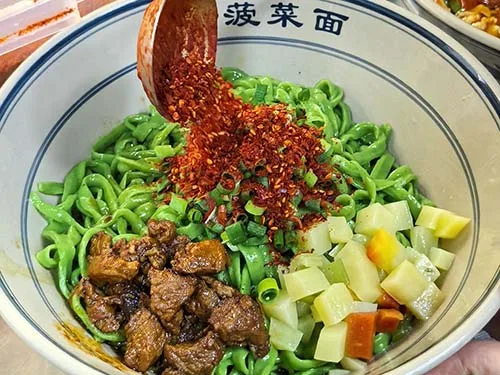
Iconic spring dishes Xi’an locals love
Handmade green noodles (the green is spinach derived) are considered an iconic spring food for local Xi’an people. These ‘seasonal’ noodles are found in noodle soups, cold noodle dishes, stirfried noodles, and hot oil noodles (biang biang noodles), by far the most popular noodle dish amongst locals.
Read more
Another typical Xi’an dish for welcoming spring is huaihua maifan, made from the edible flower of black locust blossoms. The white pea-like flowers are washed, mixed with flour, and steamed. Served and seasoned with minced garlic, vinegar, soy sauce, and chili oil, huaihua maifan has a salty yet fresh taste that is light – and delicious, naturally. For local Xi’anese, it is said if they don’t eat huaihua maifan, they have missed spring, so if you happen to be visiting during March to May, be sure to sample this traditional dish at least once.
Throughout China homemade snacks are a beautiful childhood memory for many. In keeping with this tradition, garlic chives are considered freshest and most nutritious when harvested in the spring, so you will find tender and juicy garlic chives in an assortment of dishes from stirfried eggs with garlic chives to steamed buns filled with garlic chives and tofu, or the most loved, pan-fried garlic chive ‘pocket’. Be on the lookout for local street stall specialities as you wander Xi’an’s streets.
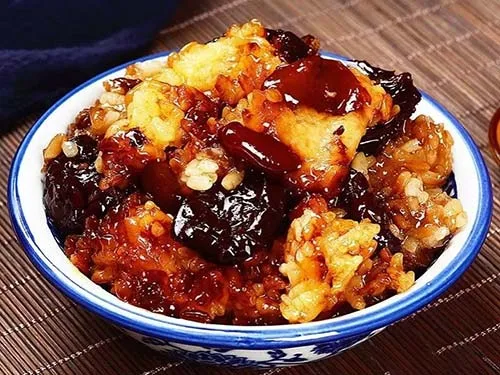
Zenggao: Sweet spring celebrations
A traditional steamed glutinous specialty, this delicious rice cake is layered with red dates, kidney beans, and white sugar. It is especially popular during spring festivals and celebrations, and why not? A soft, sweet treat, it offers the perfect ending to a day spent exploring Xi’an’s attractions, providing comfort and energy for travel adventures to come.
Xi’an in autumn: Why visit Xi’an between September and November?
As summer’s warmth recedes, Xi’an undergoes a metamorphosis from September to November. The city’s ancient stones and storied temples are framed by cascades of amber and gold as leaves change colour. Visitors will notice the air is crisper and cooler, making exploration through the city and its surrounds enjoyable and manageable.
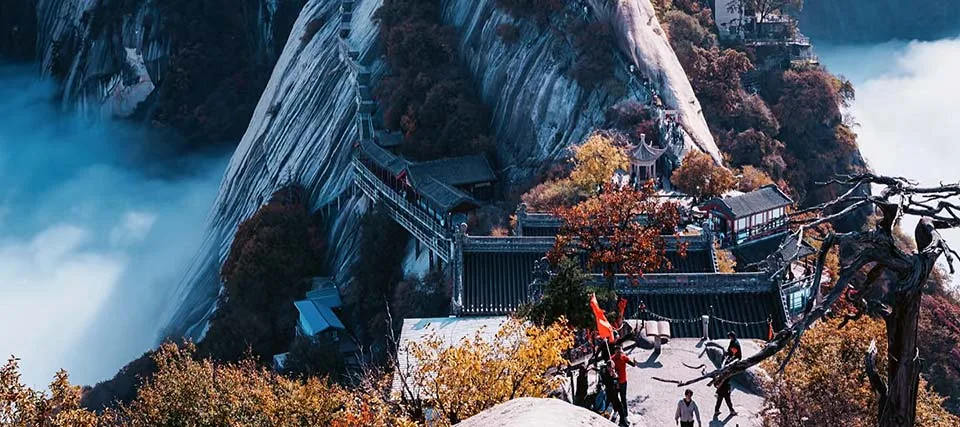
Xi’an’s best sites to visit in autumn
Mount Hua is picturesque in all seasons. In spring, there are blooming mountain flowers, in summer, overlapping emerald peaks, while in winter, there are snowcapped mountains. Autumn, however, is by far the most enchanting season in Huashan. Whether you prefer dawn, dusk, or any time in between, Mount Hua presents an exquisite canvas with its peaks dyed red by the changing maple leaves. It’s a perfect time for hiking and scenic views. Take in the towering peaks in the crisp autumn air or experience the hazy beauty of misty clouds while traversing the mountain’s plank paths.
The Small Wild Goose Pagoda is famous for its contemplative atmosphere and in autumn the tranquility is deepened by the surrounding natural scenery and artistic conception of the ‘Yanta Morning Bell’. The golden accent provided by the turning ginkgo trees make Small Wild Goose Pagoda well worth a visit in autumn.
Located in the bustling Muslim Quarter, the Great Mosque in Xi’an is truly a tranquil escape that contrasts with the melee of local markets. A complex of five courtyards blending Chinese and Islamic architecture, the garden is populated with cypress, pomegranate, jujube, apricot, and persimmon trees, each of which feature in traditional gardens. Together, they create a solemn oriental garden landscape for contemplation. In autumn, you will find persimmons ready to be ‘harvested’ here as they hang heavily from branches. With their deep burgundy hue a stunning complement to the unique blue of the buildings, you could be forgiven for thinking the slight scent of osmanthus in the air is an almost theatrical touch.
For more natural autumn beauty, visit Taiping National Forest Park. Renowned for the vibrant crimson canopy it transforms to in autumn, visitors will delight in the park’s 160 meter Rainbow Waterfall, which casts dazzling rainbows around noon on sunny days. It is definitely a magic autumn landscape.
As though framed by a golden halo of ginkgo trees, the Hanyangling Mausoleum is stunning as autumn peaks in November. This ancient burial site blends history with the best of the season’s natural beauty, embodying the perfect harmony of Xi’an’s past and present.
Xi’an’s favorite autumn culinary delights
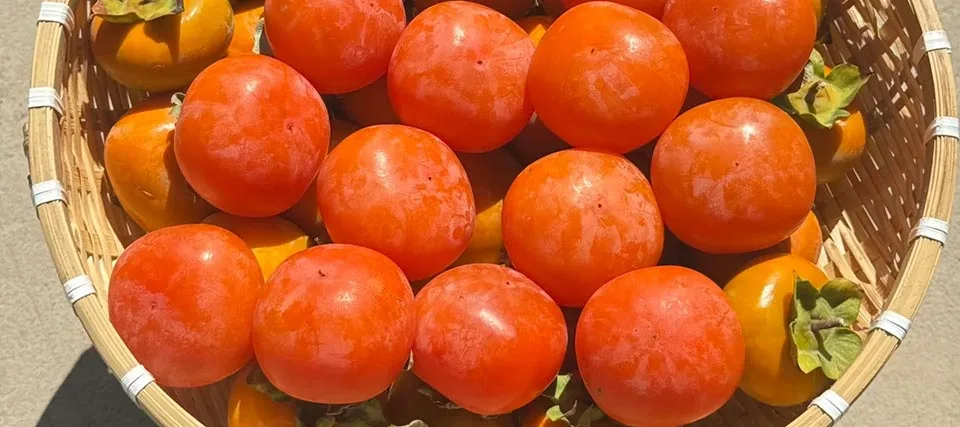
As Xi’an’s temperatures cool and the city is wrapped in autumn’s colours, its culinary scene warms up with hearty, harvest inspired flavors. From steaming bowls of lamb and bread soup to the sweet richness of fresh jujubes sold at bustling market stalls, autumn’s seasonal specialties offer comforting tastes that perfectly complement crisp days and vibrant landscapes.
Flatbread in Lamb Soup (yangrou paomo) is Xi’an’s autumn and winter favorite, especially in the Muslim Quarter. Explorers are encouraged to try it at least once. Tear pieces of flatbread into a bowl of rich lamb broth, where the bread softens perfectly before consuming. Add a little garlic paste and chili oil to enhance this hearty, warming dish that will fuel a full day of exploration.
Fresh Jujubes shine in Fuping and Dali. Fuping’s jujubes are plump with tender flesh and small pits, while Dali’s have shiny skins and are sweeter. Fresh jujubes are an antioxidant-rich superfood with high levels of vitamins and minerals. Enjoy them fresh, as the supply time is too short.
Lintong’s persimmons are regaled for their thin skin and soft, sweet flesh that is melt-in-your-mouth delicious. During harvest, visitors can pick them fresh, or enjoy sun-dried persimmon cakes made by locals. In the Muslim Quarter, fried persimmon donuts are the most popular sweet treat during autumn. Yet another persimmon inspired sweet treat is persimmon huta. Taking the paste of ripe persimmons, this is combined with flour in a round shallow spatula, then deep fried. Yes, it tastes as good as it sounds. A well earned treat after exploring Xi’an’s streets.
Like the persimmons of Lintong, the pomegranates from here are widely appreciated. With a deep heritage tied to imperial royal families, Lintong’s are also famous for their large size, thin skin, juicy texture, sweet taste, soft core, and excellent quality. Xi’an markets sell the ruby-red seeds in cups – a delicious, refreshing snack on a crisp autumn day. Not a fan of seeds? No problem. Quench your thirst with a freshly squeezed pomegranate juice and discover what locals love about this special fruit.
Xi’an highlights by month
Looking for a detailed breakdown of Xi’an highlights by month. We’ve captured it all here. Keep in mind that event dates are changeable year to year and although our trusty team of guides aim to always provide the latest information, we recommend you check websites and event organisers to ensure you have the most up to date details.
| Month | Weather | Holidays | Special Events | Major Exhibitions & Conferences |
|---|---|---|---|---|
| January | -4.4°C to 5.0°C | New Year’s Day | New Year Celebrations – New Year’s Day festivities (Jan 1) | — |
| February | -1.1°C to 9.3°C | Chinese New Year | Xi’an City Wall Lantern Festival: elaborate lantern displays, cultural performances, and Tang Dynasty themes. | — |
| March | 3.9°C to 15.5°C | End of Lantern Festival | Xi’an City Wall Lantern Festival continues through March 9 | 1. Xi’an Machine Tool Expo (XME). 2. Xi’an International Intelligent Warehousing Equipment & Application Tech Exhibition. |
| April | 9.2°C to 22.1°C | Qingming Festival | Flower Festival:features flower viewing ceremonies. | 1. ROUTES ASIA; 2. CNHE 2026: International Xi’an China Exhibition on Heat and Warm Supply & Air Conditioner Boiler Technological Equipment. |
| May | 13.9°C to 26.9°C | Labor Day Holiday | Silk Road International Film Festival: Major trade exhibition. | 1. HOSFAIR XI’AN 2026: China International Hospitality Equipment, Supplies, Food & Beverage Fair. 2. XI’AN COFFEE TRADE FAIR 2026 |
| June | 18.7°C to 31.7°C | Dragon Boat Festival | Dragon Boat Festival: Traditional festival with dragon boat races and cultural celebrations. | — |
| July | 21.7°C to 32.8°C | Summer school holiday | Summer Cultural Programs: various music concerts and cultural performances at venues like Xi’an Concert Hall. | — |
| August | 20.5°C to 30.7°C | — | Tang Dynasty Never Sleep City: an immersive cultural experience combining ancient Chinese civilization with modern technology. | — |
| 15.8°C to 25.4°C | Mid-Autumn Festival | Xi’an Ancient Culture and Art Festival: Annual celebration held every September | WPE & WHPE – WORLD OF PLANT EXTRACTS & INNOVATIVE NATURAL INGREDIENTS EXPO 2025 Euro-Asia Economic Forum (23-25 Sep 2025) | |
| October | 9.8°C to 19.3°C | National Day Golden Week October 1 – 7 | Xi’an Night Museum Tours: the city’s renowned cultural heritage sites illuminated for evening exploration. | GLOBAL TEA FAIR CHINA – XI’AN 2025 |
| November | 2.8°C to 12.6°C | — | Xi’an City Wall International Marathon | — |
| December | -2.7°C to 6.6°C | Christmas activities | New Year’s Eve Countdown at Wangfujing | — |
Insider tips for timing your flight booking to Xi’an

Planning a trip to Xi’an from the US, Europe or Australia requires smart timing to capitalize on reduced seasonal rates and to avoid peak travel periods like Chinese New Year or the National public holiday week in October. While there are no direct flights – so expect at least one connection via Beijing, Shanghai, or Hong Kong (hint: that’s the perfect way to see more of China) – there are ways to get around these factors. Here’s our team’s best suggestions:
Book early and smart
- It might sound like we’re starting the obvious, but where possible book three to six months ahead for better fares, seats, and connections. Prices often jump two to three months before scheduled departure dates.
- Target September to October for pleasant weather and fares that are generally ten to 20 percent lower than other popular travel periods.
- Avoid June through to August and December when demand and prices peak.
Maximize savings
- Set fare alerts four to six months out and watch for midweek dips.
- Choose weekday departures as they are often 15 to 25 percent cheaper than weekends.
- Consider early morning or late night flights to capture additional savings.
Plan connections carefully
- Do we need to say that tight connections increase stress and the risk of missed flights? Our top tip here is to allow a minimum of two to three hours for layovers in Beijing, Shanghai, or Hong Kong to clear security/customs. These airports are huge and busy, so leaving ample time to avoid last minute panic or rushing is wise.
- Have more time between trips than anticipated? We recommend making the most of it by turning layovers into mini adventures. Research ahead and find out what is possible in a day layover. You could find yourself ticking another destination off your bucket list.
- Use multi-city/stopover tickets to spend one or two days in the hub city, then continue to Xi’an, often with little or no extra fare charges. And the bonus? A short stop in Beijing, Shanghai, or Hong Kong breaks up long travel and adds to your travel memories.
Be flexible
- If there is one thing travel does is challenge our need for rigid routines. Our big tip here is to remain flexible. Compare routes and mix airlines if needed. Why? Because separate one way tickets can sometimes reduce overall costs.
- Flexibility on dates and times can also help travelers capture the best value. Be patient and research thoroughly. It does pay dividends and it means more money in your traveling pocket.
- With early booking, smart scheduling, and well-planned connections or stopovers, the journey to Xi’an becomes smoother, better value, and more enjoyable.


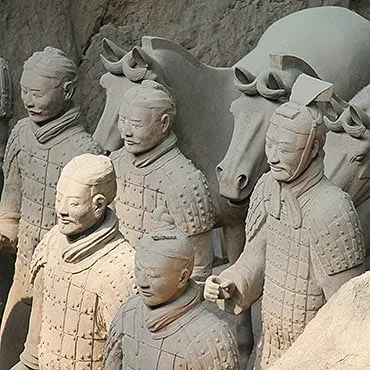

 First Time Traveller 10/10
First Time Traveller 10/10





